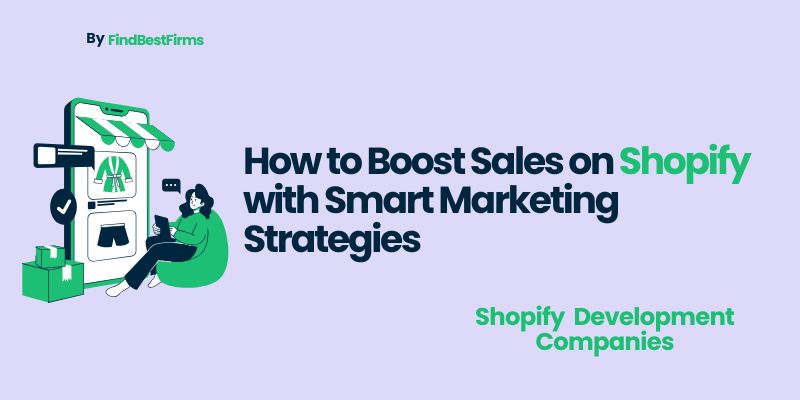The current dynamic environment of eCommerce requires more than just posting items and letting the sales process occur with a Shopify store. What actually happens is that the actual growth commences once you know how to market your store in an effective manner that draws not only visitors but also people who will want to come back. Every month new online stores multiply by thousands and to get noticed, an excellent product is not enough; a data-driven marketing strategy should be considered.
Shopify has come to be recognized as one of the most dependable and effective scaling eCommerce systems that have assisted millions of entrepreneurs to establish online stores. However, even with its sophisticated features and integrations, there are quite a number of store owners who are unable to increase sales due to their failure to consider the marketing aspect of the equation. Marketing is not the last minute thing and it is the gas that drives the recognition, interaction and conversion of your store.
Marketing smartly does not mean spending more money on advertisements, it means making wise choices. It is knowing your customers, establishing genuine relationships, and applying the features of Shopify in a strategic manner. This blog is aimed to discuss effective and tested methods that can assist you to sell more, to retain more and to expand your Shopify business in a sustainable way.

Understanding Shopify’s Built-In Marketing Ecosystem
Shopify is not just an eCommerce site, it is an ecosystem that is meant to make marketing, selling and running business easier. It offers a powerful suite of native tools that can enable business owners to market products, perform analysis as well as automation of campaigns at very little effort. Such tools as Shopify Email, Shopify Audiences, and built-in SEO capabilities can enable even a small business owner to promote their stores successfully without the necessity to have a team of people.
Shopify has an app ecosystem that allows smooth interoperability with third-party marketing systems such as Klaviyo, Omnisend, and Google Analytics. These integrations will enable you to make data-driven decisions and customer-behavior tracking by conducting cross-channel campaigns. Through such tools, the brands will be able to simplify their operations and concentrate on what is really important, enhancing consumer experience and conversion.
The magic though is in the collective use of these tools. Effective Shopify stores are a combination of SEO optimization, automation, analytics, and personalization to build a coherent approach. By collaborating with experienced Shopify Developers, all these factors will be in harmony with each other, and offer an engaging experience that will lead to sales and engagement.
Optimize Your Shopify Store for Conversions
Your Shopify store should be conversion-optimized before you invest time and money on marketing. Imagine your web site as your store front. It is supposed to be attractive to the eyes, simple to navigate and quick to load. Research indicates that consumers abandon websites that take more than three seconds to load and therefore the speed of your site ought to be your first priority. Image compression, reduction of code and a lightweight theme can help a lot.
User experience (UX) is also important in conversion optimization. Having a proper design, where the call-to-action (CTA) buttons are very visible, interesting images, and making the description of products short and to the point can skyrocket sales. Ensure that your Add to Cart button is visible and compelling and incorporate social proof to create a feeling of trust, e.g., in the form of reviews and testimonials. Cart abandonment can also be minimized through streamlining the checkout process by enabling the guest checkouts and various payment methods.
And the last is personalization which largely contributes to making visitors buyers. The more you can personalize your product suggestions, home page banners and offers according to how the user behaves, the more you are likely to increase engagement. There are numerous prosperous Shopify Development Companies that deal with the creation of conversion-oriented stores that integrate beauty with rational functionality that make every click push one a step closer to a purchase.
Master Shopify SEO for Organic Traffic
Among the owners of Shopify stores, Search Engine Optimization (SEO) is one of the most effective and least utilized strategies. The organic traffic creates long-term visibility and assists in minimizing the reliance on the paid advertisements. The SEO features of the Shopify are editable meta title, meta description and automatic generation of sitemaps. Nonetheless, to really be one of the results of search engines, you will also have to go the extra mile and come up with quality content filled with keywords.
Begin by maximizing your products titles and description using the relevant keywords which are being searched by the customers. Label all product pictures with alt tags and have a clean and easy to use URL structure. Another good strategy of SEO is content marketing. Having a blog about topics of interest, such as buying tips, product maintenance advice, customer testimonials, etc, can bring in new clients and make your brand an expert.
The creation of back links with competent websites will also enable you to boost your domain authority and ranking in search. In the long run, there is a steady increase in the traffic of an SEO-optimized Storey of Shopify, most of which are willing to purchase goods and services. Organic marketing may not give immediate results, though it would provide credibility, trust, and sustainable growth essential elements of success in the long term.
Leverage the Power of Email Marketing
In reality, email marketing is not a dead channel, as it is among the highest ROI platforms of Shopify stores. It is a cheap and efficient method of cultivating leads, turning around prospective buyers, and retaining the current clientele. Individualization and automation are the key. Such tools as Klaviyo or Omnisend are optimally compatible with Shopify and allow automated workflows to deliver the right message at the right time to the right person.
The initial email campaign needs to be relationship oriented but not sales oriented. New subscribers feel attached by welcome emails that present the story of your brand and best products. Send follow up emails on abandoned carts to recover the lost sales and re-engagement emails to win back the inactive users. Remember to divide your audience according to the purchase behavior, location or interests so as to engage them more.
In addition to transactional messages, use newsletters to introduce education or promotions or special deals. The less generic and more personal a personalized email is, the more chances of conversion. Effective email marketing plan maintains contacts and makes your brand always remembered in the minds of your audience and can make returns on sales in the long run.
Amplify Your Reach Through Social Media Marketing
Social media has transformed from a communication tool into a powerful sales channel. Platforms like Instagram, Facebook, Pinterest, and TikTok allow brands to connect with customers visually and emotionally. Shopify’s seamless integration with these platforms enables direct selling through shoppable posts and in-app checkout options, reducing friction in the buyer journey.
Visual storytelling plays a crucial role here. High-quality images, engaging videos, and user-generated content make your brand more relatable. Collaborating with micro-influencers in your niche can also help you reach highly targeted audiences. Meanwhile, paid social ads, when done strategically, can amplify your reach and bring potential buyers directly to your store.
It’s also essential to engage with your audience consistently. Reply to comments, run polls, and create interactive content that invites participation. A strong social presence not only drives sales but also strengthens your brand identity, turning casual followers into loyal customers who advocate for your products.
Maximize ROI with Paid Advertising
While organic strategies are crucial, paid advertising accelerates your growth when used wisely. Shopify integrates easily with ad platforms like Google Ads, Facebook Ads, and TikTok Ads, allowing you to run targeted campaigns directly from your dashboard. Paid ads help you reach potential buyers faster by targeting users based on demographics, interests, and past behavior.
The most successful Shopify stores don’t just run ads; they analyze and optimize them. Use A/B testing to compare different creatives, headlines, or CTAs. Track key metrics like click-through rate (CTR) and conversion rate to identify what works best. Retargeting ads, in particular, are powerful for re-engaging users who showed interest but didn’t complete a purchase.
However, it’s important not to overspend on ads without tracking ROI. Every dollar spent should bring measurable results. When combined with a well-optimized store and strong organic strategy, paid advertising becomes a powerful sales driver that scales your brand sustainably.
Utilize Shopify Apps and Integrations
Shopify’s app ecosystem is one of its biggest strengths. With thousands of apps available, you can enhance functionality, automate marketing, and personalize customer experiences without extensive coding. For instance, apps like Loox help gather reviews, while Privy can capture leads through pop-ups and exit-intent offers.
These tools allow even small businesses to run sophisticated marketing campaigns without technical challenges. You can also use analytics apps to track behavior, email tools for automation, and loyalty programs to encourage repeat purchases. The key is choosing the right combination that fits your business goals rather than overcrowding your store with unnecessary apps.
Partnering with expert Shopify Developers ensures proper app integration without compromising speed or security. Developers understand how to customize functionalities and optimize performance, allowing your marketing strategies to work seamlessly behind the scenes while you focus on growing your business.
Personalize the Customer Experience
Personalization is the future of eCommerce. Modern shoppers expect brands to understand their preferences and deliver tailored experiences. Shopify provides the flexibility to personalize everything from homepage banners and product recommendations to discounts and email content. Personalization not only improves engagement but also boosts average order value (AOV).
AI-powered tools can analyze user behavior and suggest products based on browsing history or previous purchases. Personalized discounts and loyalty rewards make customers feel valued, increasing their likelihood of returning. You can even create personalized landing pages or recommendation sections that cater to specific audience segments.
The key is to use personalization thoughtfully, not invasively. Customers should feel that their experience is unique, not that their data is overused. When done right, personalization builds loyalty and transforms one-time buyers into long-term brand advocates.
Measure, Analyze, and Improve
Data is at the heart of every successful marketing strategy. Shopify Analytics gives you access to detailed insights into your store’s performance, helping you identify what’s working and what needs improvement. From tracking customer acquisition sources to analyzing conversion rates, every metric tells a story about your customers’ journey.
Monitoring metrics like average order value, repeat purchase rate, and abandoned cart percentage can help you fine-tune campaigns. Regular analysis ensures that your efforts are aligned with customer behavior and business goals. Use tools like Google Analytics and heatmaps to visualize user activity and make data-driven decisions.
The most successful eCommerce stores adopt a cycle of testing, analyzing, and refining. Marketing isn’t static, trends evolve, and so do customer expectations. By continuously learning and improving, you can stay ahead of the competition and achieve consistent growth on Shopify.
Summary
Boosting sales on Shopify isn’t about shortcuts or overnight success. It’s about combining smart marketing with consistent effort, creativity, and customer understanding. Shopify provides the tools, but it’s your strategy that turns them into results. From SEO and email automation to social media and personalization, each tactic contributes to building a strong, profitable brand.
If you’re serious about scaling your store, consider partnering with experienced Shopify Development Companies that understand how to blend design, functionality, and marketing strategy. Their expertise ensures that every technical and creative element of your store works together to maximize conversions and brand impact.

